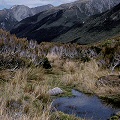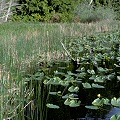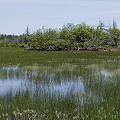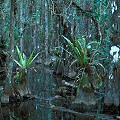Q: Utricularia and conservation
 Utricularia;
Utricularia;
New Zealand habitat Utricularia;
Utricularia;
British Columbia habitat Utricularia;
Utricularia;
California habitat Utricularia;
Utricularia;
Florida habitat
A: Most Utricularia species have relatively large ranges, and
this protects them against significant damage at human hands. However, there are a few clear indicators that habitat
destruction and degradation---which is reducing the habitat available to life on Earth---is likely to have an increasing impact
on Utricularia:
1)According to Taylor, twenty species have been collected as few as five times. This suggests they are either in very under-studied
areas, or are very rare species with extremely limited populations. These species are:
U. albiflora, U. antennifera, U. aureomaculata,
U. buntingiana, U. choristotheca,
U. corynephora,
U. forrestii, U. georgei, U. helix,
U. leptorhyncha, U. letestui, U. naviculata,
U. perversa,
U. petersoniae, U. physoceras, U. salwinensis,
U. steyermarkii, U. terrae-reginae,
U. tridactyla, and U. warburgii.
2)According to Taylor, an additional eight species are only known from their original collections. Again, it is not clear if these
are rare plants, or simply undercollected plants:
U. cheiranthos, U. determannii, U. garrettii,
U. hintonii, U. kenneallyi, U. mirabilis,
U. peranomala, and U. rhododactylos.
3)Utricularia podadena has only been collected twice from locations that have been destroyed by
agriculture, so it is probably extinct.
4)The Japanese U. dimorphantha is highly endangered in the wild.
5)Some aquatic species such as U. stygia are extremely rare in Europe, with many of its
original sites having been destroyed.
6)Utricularia amethystina is apparently extinct in the USA, although populations still exist in
Latin America.
Page citations: Rice, B.A. 2003c, 2006a;
Taylor, P. 1989; personal observations.